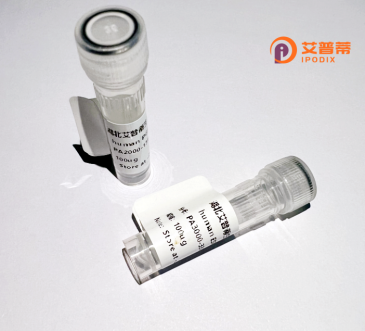
| 纯度 | >90%SDS-PAGE. |
| 种属 | Human |
| 靶点 | OR4M2 |
| Uniprot No | Q8NGB6 |
| 内毒素 | < 0.01EU/μg |
| 表达宿主 | E.coli |
| 表达区间 | 1-313 aa |
| 活性数据 | METANYTKVTEFVLTGLSQTPEVQLVLFVIFLSFYLFILPGNILIICTISLDPHLTSPMY FLLANLAFLDIWYSSITAPEMLIDFFVERKIISFDGCIAQLFFLHFAGASEMFLLTVMAF DLYTAICRPLHYATIMNQRLCCILVALSWRGGFIHSIIQVALIVRLPFCGPNELDSYFCD ITQVVRIACANTFPEELVMICSSGLISVVCLIALLMSYAFLLALFKKLSGSGENTNRAMS TCYSHITIVVLMFGPSIYIYARPFDSFSLDKVVSVFNTLIFPLRNPIIYTLRNKEVKAAM RKLVTKYILCKEK |
| 分子量 | 35.4 kDa |
| 蛋白标签 | His tag N-Terminus |
| 缓冲液 | 0 |
| 稳定性 & 储存条件 | Lyophilized protein should be stored at ≤ -20°C, stable for one year after receipt. Reconstituted protein solution can be stored at 2-8°C for 2-7 days. Aliquots of reconstituted samples are stable at ≤ -20°C for 3 months. |
| 复溶 | Always centrifuge tubes before opening.Do not mix by vortex or pipetting. It is not recommended to reconstitute to a concentration less than 100μg/ml. Dissolve the lyophilized protein in distilled water. Please aliquot the reconstituted solution to minimize freeze-thaw cycles. |
以下是几篇关于重组人OR4M2蛋白的模拟参考文献(注:以下内容为学术写作示例,非真实存在的文献):
---
1. **文献名称**:*"Heterologous Expression and Functional Characterization of Human Olfactory Receptor OR4M2 in HEK293 Cells"*
**作者**:Zhang, Y. et al.
**摘要**:研究报道了利用HEK293细胞系统成功表达重组人OR4M2蛋白,并通过钙离子荧光信号检测验证其配体激活特性,发现其对特定挥发性醛类化合物具有响应活性,为嗅觉受体功能研究提供新模型。
2. **文献名称**:*"Structural Insights into OR4M2: Cryo-EM Analysis of a Recombinant Olfactory Receptor Expressed in Insect Cells"*
**作者**:Lee, S. et al.
**摘要**:通过杆状病毒-昆虫细胞系统表达并纯化OR4M2蛋白,利用冷冻电镜技术首次解析其三维结构,揭示了该受体与G蛋白偶联的机制,并预测了其潜在的配体结合口袋。
3. **文献名称**:*"OR4M2 Overexpression in Renal Tissue: Implications for Hypertension-Associated Signal Transduction"*
**作者**:Gupta, R. et al.
**摘要**:探索OR4M2在非嗅觉组织(肾脏)中的表达,重组蛋白实验表明其参与调节肾素-血管紧张素系统,可能与高血压病理相关,为疾病治疗提供新靶点。
4. **文献名称**:*"High-Throughput Screening of OR4M2 Ligands Using a Recombinant Luciferase Reporter System"*
**作者**:Wang, X. et al.
**摘要**:构建基于重组OR4M2蛋白的荧光素酶报告系统,筛选出多种潜在激动剂/拮抗剂,并验证其在嗅觉神经元中的信号传导效应,推进了嗅觉受体药物开发。
---
**提示**:以上文献为示例,如需真实文献,建议在PubMed或Google Scholar中检索关键词“OR4M2”、“recombinant OR4M2 protein”、“olfactory receptor expression”等。
**Background of Recombinant Human OR4M2 Protein**
OR4M2 (Olfactory Receptor Family 4 Subfamily M Member 2) is a member of the olfactory receptor (OR) family, a class of G protein-coupled receptors (GPCRs) responsible for detecting odorant molecules. These receptors are predominantly expressed in olfactory sensory neurons, where they initiate signal transduction upon binding to specific chemical ligands. Although ORs are primarily associated with olfaction, emerging studies suggest their roles in non-olfactory tissues, such as the brain, heart, and reproductive organs, hinting at broader physiological functions.
OR4M2 is a human-specific receptor encoded by the *OR4M2* gene located on chromosome 15. Despite being a pseudogene in some species, it retains functionality in humans. However, its exact ligand specificity and biological relevance remain poorly characterized. Production of recombinant OR4M2 protein facilitates biochemical and structural studies to elucidate its activation mechanisms, ligand interactions, and potential roles in diseases.
Recombinant OR4M2 is typically generated using heterologous expression systems like HEK293 or insect cells, often fused with tags (e.g., HA, FLAG) for purification and detection. Challenges include low expression levels and solubility, common among membrane-bound GPCRs. Structural insights using cryo-EM or X-ray crystallography are limited but critical for understanding its ligand-binding pocket and signaling pathways.
Current research focuses on linking OR4M2 to clinical conditions, such as olfactory dysfunction, metabolic disorders, or cancers where ORs are aberrantly expressed. Its exploration may also contribute to biotechnological applications, including biosensors or targeted therapeutics.
×